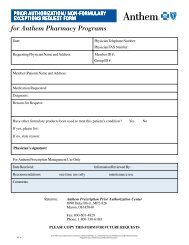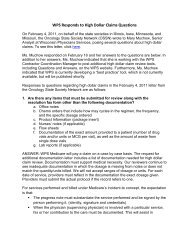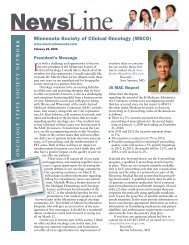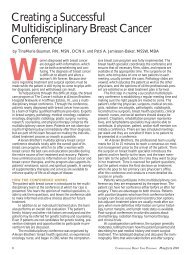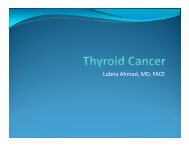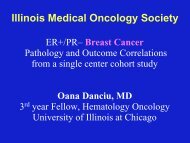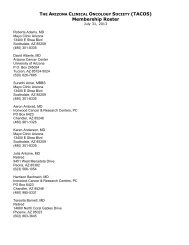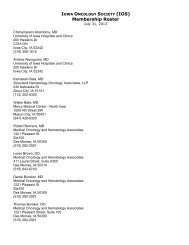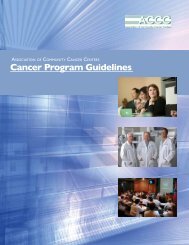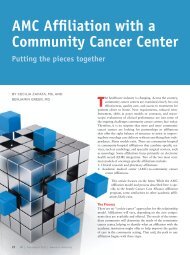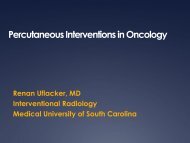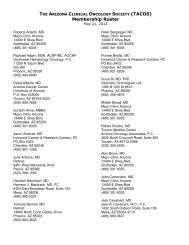2013 Patient Assistance and Reimbursement Guide - Association of ...
2013 Patient Assistance and Reimbursement Guide - Association of ...
2013 Patient Assistance and Reimbursement Guide - Association of ...
Create successful ePaper yourself
Turn your PDF publications into a flip-book with our unique Google optimized e-Paper software.
Table 1. <strong>Patient</strong> Eligibility Criteria for Rex Assist<br />
<strong>and</strong> <strong>of</strong>fers the additional resources <strong>of</strong><br />
case management <strong>and</strong> referral within the<br />
community.<br />
The Oncology Continuum at<br />
Rex Healthcare<br />
Rex Cancer Center was the first in the<br />
region to earn national recognition as<br />
a Comprehensive Community Cancer<br />
Center through the American College <strong>of</strong><br />
Surgeons Commission on Cancer (CoC)<br />
<strong>and</strong> was also the first Comprehensive<br />
Breast Care Center in the area. In addition<br />
to the Rex Cancer Center, which<br />
houses medical <strong>and</strong> radiation oncology,<br />
many departments within Rex Healthcare<br />
<strong>and</strong> several physician practices<br />
provide care to oncology patients from<br />
detection to treatment. Because patient<br />
care spans across these business entities,<br />
financial assistance is complicated. As<br />
the patient moves through the cancer care<br />
continuum many additional bills may be<br />
generated. Some services do not qualify<br />
for Rex Financial <strong>Assistance</strong>; others have<br />
separate financial assessment <strong>and</strong> support<br />
programs. Non-eligible care furthers the<br />
complexity <strong>of</strong> resource management for<br />
patients. Given this complexity, our staff<br />
works to ensure that patients underst<strong>and</strong><br />
the differences in service delivery <strong>and</strong><br />
have access to the appropriate resources<br />
Forgiveness <strong>of</strong> Debt 2012 Federal Poverty Traditional Charity<br />
<strong>Guide</strong>lines<br />
Care 100% <strong>of</strong> Past<br />
<strong>and</strong> 6 Months Into<br />
the Future (Some<br />
Exceptions Apply)<br />
% <strong>of</strong> Federal Poverty <br />
<strong>Guide</strong>lines < = 250%<br />
Family Size <strong>of</strong> 1 $11,170 $27,925<br />
Family Size <strong>of</strong> 2 $15,130 $37,875<br />
Family Size <strong>of</strong> 3 $19,090 $47,725<br />
Family Size <strong>of</strong> 4 $23,050 $57,325<br />
Family Size <strong>of</strong> 5 $27,010 $67,525<br />
Family Size <strong>of</strong> 6 $30,970 $77,425<br />
Family Size <strong>of</strong> 7 $34,930 $87,325<br />
Family Size <strong>of</strong> 8 $38,890 $97,225<br />
For each additional person $3,820<br />
that are aligned with each service type<br />
(see Table 2, page 7).<br />
Navigation Services<br />
Seven years ago, the Rex <strong>Patient</strong> Care<br />
Navigation program was established with<br />
a Duke Endowment grant to provide<br />
navigation to breast cancer patients.<br />
Since then, our program has grown to<br />
4.7 FTE RNs, providing navigation<br />
services for those diagnosed with breast,<br />
gastrointestinal, <strong>and</strong> thoracic cancers.<br />
Our navigation team engages with<br />
patients whenever care is being provided<br />
within Rex Healthcare. These navigators:<br />
●●<br />
Assess patients for financial distress<br />
●●<br />
Refer appropriate patients to hospital<br />
<strong>and</strong>/or departmental resources<br />
●●<br />
Reassure patients about available<br />
resources<br />
●●<br />
Follow up with patients regarding<br />
the process <strong>of</strong> accessing financial<br />
resources.<br />
Often, our navigators are a trusted source<br />
<strong>of</strong> information that patients will turn<br />
to when reluctant to engage with other<br />
6<br />
A Legacy <strong>of</strong> Philanthropic Care<br />
In 1894 John Rex, a tanner from<br />
Raleigh, N.C., made several<br />
bequests to found Rex Hospital. His<br />
last will <strong>and</strong> testament directed:<br />
I give <strong>and</strong> bequeath...all<br />
money belonging to me...<br />
to provide a comfortable<br />
retreat for the sick <strong>and</strong> afflicted<br />
poor belonging to the<br />
city <strong>of</strong> Raleigh in which they<br />
may have the benefit <strong>of</strong><br />
skillful medical aid <strong>and</strong><br />
proper attention.<br />
Rex Healthcare has grown from a staff<br />
<strong>of</strong> seven working in the converted home<br />
<strong>of</strong> former Governor Charles Manly<br />
to becoming the leading healthcare<br />
provider for Wake County, N.C., <strong>and</strong> its<br />
surrounding communities.<br />
Now a member <strong>of</strong> UNC Health<br />
Care, Rex Healthcare is a private, notfor-pr<strong>of</strong>it<br />
healthcare system with more<br />
than 5,400 employees. Rex Healthcare<br />
has 660 beds <strong>and</strong> treats nearly 34,000<br />
inpatients annually. Rex Healthcare’s<br />
medical staff includes more than<br />
1,100 physicians <strong>and</strong> 1,700 nurses.<br />
Wherever patients enter the Rex<br />
Healthcare system, staff is available<br />
to address the financial concerns <strong>of</strong><br />
patients <strong>and</strong> families <strong>and</strong> ensure that<br />
they receive the best care possible.<br />
Rex Healthcare’s mission: to provide<br />
the best in health services by bringing<br />
together compassionate care <strong>and</strong><br />
leading-edge technology. Bottom line:<br />
Rex Healthcare is committed to providing<br />
the best health services to everyone<br />
in the communities that we serve—<br />
regardless <strong>of</strong> their ability to pay.<br />
Of course, when John Rex identified<br />
“the afflicted poor” in his bequest,<br />
he could not have foreseen the extraordinary<br />
rise in healthcare costs <strong>and</strong><br />
that these costs would consume<br />
an enormous percentage <strong>of</strong> the GDP,<br />
now at almost 20 percent. Today,<br />
a tumultuous economy <strong>and</strong> high<br />
unemployment have significantly<br />
reduced the number <strong>of</strong> people eligible<br />
for workplace-sponsored insurance,<br />
<strong>and</strong> increasing numbers <strong>of</strong> underinsured<br />
<strong>and</strong> uninsured patients enter<br />
our healthcare system daily to receive<br />
needed treatment for cancer.<br />
<br />
ACCC <strong>2013</strong> <strong>Patient</strong> <strong>Assistance</strong> <strong>and</strong> <strong>Reimbursement</strong> <strong>Guide</strong>



